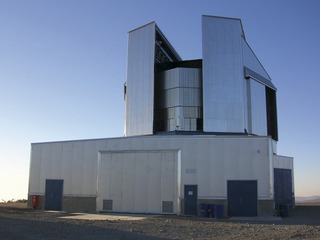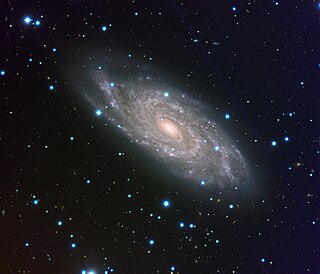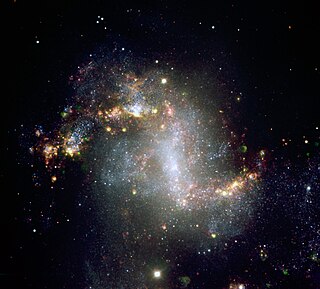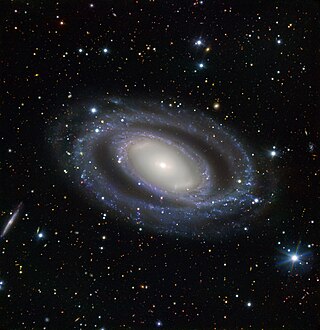
The VISTA is a wide-field reflecting telescope with a 4.1 metre mirror, located at the Paranal Observatory in Chile. It is operated by the European Southern Observatory and started science operations in December 2009. VISTA was conceived and developed by a consortium of universities in the United Kingdom led by Queen Mary University of London and became an in-kind contribution to ESO as part of the UK's accession agreement, with the subscription paid by the UK Science and Technology Facilities Council (STFC).

Messier 77 (M77), also known as NGC 1068 or the Squid Galaxy, is a barred spiral galaxy in the constellation Cetus. It is about 47 million light-years (14 Mpc) away from Earth. Messier 77 was discovered by Pierre Méchain in 1780, who originally described it as a nebula. Méchain then communicated his discovery to Charles Messier, who subsequently listed the object in his catalog. Both Messier and William Herschel described this galaxy as a star cluster. Today, however, the object is known to be a galaxy.

NGC 1365, also known as the Great Barred Spiral Galaxy, is a double-barred spiral galaxy about 56 million light-years away in the constellation Fornax.

NGC 7331, also known as Caldwell 30, is an unbarred spiral galaxy about 40 million light-years (12 Mpc) away in the constellation Pegasus. It was discovered by William Herschel in 1784. NGC 7331 is the brightest galaxy in the field of a visual grouping known as the NGC 7331 Group of galaxies. In fact, the other members of the group, NGC 7335, 7336, 7337 and 7340, lie far in the background at distances of approximately 300-350 million light years.

NGC 1532, also known as Haley's Coronet, is an edge-on barred spiral galaxy located approximately 50 million light-years from the Solar System in the constellation Eridanus. The galaxy was discovered by James Dunlop on 29 October 1826.

NGC 1097 is a barred spiral galaxy about 45 million light years away in the constellation Fornax. It was discovered by William Herschel on 9 October 1790. It is a severely interacting galaxy with obvious tidal debris and distortions caused by interaction with the companion galaxy NGC 1097A.

NGC 1309 is a spiral galaxy located approximately 120 million light-years away, appearing in the constellation Eridanus. It is about 75,000 light-years across, and is about 3/4s the width of the Milky Way. Its shape is classified as SA(s)bc, meaning that it has moderately wound spiral arms and no ring. Bright blue areas of star formation can be seen in the spiral arms, while the yellowish central nucleus contains older-population stars. NGC 1309 is one of over 200 members of the Eridanus Group of galaxies.

NGC 5090 and NGC 5091 are a set of galaxies approximately 160 million light-years away in the constellation Centaurus. They are in the process of colliding and merging with some evidence of tidal disruption of NGC 5091.

NGC 3190 is a spiral galaxy with tightly wound arms and lying in the constellation Leo. It was discovered by William Herschel in 1784. NGC 3190 is member of Hickson 44 galaxy group, estimated at around 80 million light years away, and consisting of four galaxies in a tight group - NGC 3193 is fairly featureless, NGC 3187 is a dim but striking spiral galaxy and NGC 3185 has a barred spiral structure with an outer ring. It is also a member of the NGC 3190 Group of galaxies, which is a member of the Leo II Groups, a series of galaxies and galaxy clusters strung out from the right edge of the Virgo Supercluster.

NGC 6118 is a grand design spiral galaxy located 83 million light-years away in the constellation Serpens. It measures roughly 110,000 light-years across; about the same as our own galaxy, the Milky Way. Its shape is classified as "SA(s)cd," meaning that it is unbarred and has several rather loosely wound spiral arms. The large numbers of bright bluish knots are active star-forming regions where some very luminous and young stars can be perceived.

NGC 4921 is a barred spiral galaxy in the Coma Cluster, located in the constellation Coma Berenices. It is about 320 million light-years from Earth. The galaxy has a nucleus with a bar structure that is surrounded by a distinct ring of dust that contains recently formed, hot blue stars. The outer part consists of unusually smooth, poorly distinguished spiral arms.

NGC 1313 is a field galaxy and a barred spiral galaxy discovered by the Scottish astronomer James Dunlop on 27 September 1826. It has a diameter of about 50,000 light-years, or about half the size of the Milky Way.

NGC 1433 is a barred spiral galaxy with a double ring structure located in the constellation of Horologium. It is at a distance of 46 million light-years from Earth. It is a Seyfert galaxy with an active galactic nucleus. The central region of the galaxy displays intense star formation activity, with an irregular star-forming ring of 5″ radius and weak radio wave emission. Star formation is also noticeable in the spiral arms but not the bar of the galaxy. NGC 1433 is being studied as part of a survey of 50 nearby galaxies known as the Legacy ExtraGalactic UV Survey (LEGUS). A jet of material flowing away from the central black hole of the galaxy extending for only 150 light-years has been found. It is the smallest molecular outflow ever observed in a galaxy beyond our own.

NGC 2217 is a nearly face-on lenticular galaxy of about 100 thousand light-years across that lies roughly 65 million light years from Earth in the constellation of Canis Major. It is part of the NGC 2217 Group of galaxies. It is classified as a barred spiral galaxy.

NGC 1398 is an isolated barred spiral galaxy exhibiting a double ring structure. It is located 65 million light years from the Earth, in the constellation of Fornax. The galaxy, with a diameter of 135,000 light years, is bigger than the Milky Way. Over 100 billion stars are in the galaxy. It was first discovered by Friedrich Winnecke of Karlsruhe, Germany, on 17 December 1868, while he was searching for comets.

The Visible Multi-Object Spectrograph (VIMOS) is a wide field imager and a multi-object spectrograph installed at the European Southern Observatory's Very Large Telescope (VLT), in Chile. The instrument used for deep astronomical surveys delivers visible images and spectra of up to 1,000 galaxies at a time. VIMOS images four rectangular areas of the sky, 7 by 8 arcminutes each, with gaps of 2 arcminutes between them. Its principal investigator was Olivier Le Fèvre.

NGC 986 is a barred spiral galaxy in the southern constellation of Fornax, located about 76 million light-years away. It was discovered on August 5, 1826 by the Scottish astronomer James Dunlop, who described it as a "faint nebula, of an irregular round figure". The galaxy has an angular size of 3′.8 × 1′.9 with a visual magnitude of 10.9. It belongs to the Fornax Cluster of galaxies. This galaxy has a nearby companion, NGC 986A, at an angular separation of 17′, corresponding to a projected separation of 110 kpc. The two appear unconnected.

NGC 1964 is a barred spiral galaxy in the constellation Lepus. The galaxy lies 65 million light years away from Earth, which means, given its apparent dimensions, that NGC 1964 is approximately 100,000 light years across. At its center lies a supermassive black hole, with estimated mass 2.5 × 107M☉. The galaxy features two tightly wound inner spiral arms within a disk with high surface brightness and two outer, more open spiral arms that originate near the inner ring. The outer arms feature few small HII regions.

NGC 7098 is a doubled barred spiral galaxy located about 95 million light-years away from Earth in the constellation of Octans. NGC 7098 has an estimated diameter of 152,400 light-years. NGC 7098 was discovered by astronomer John Herschel on September 22, 1835.

ESO 269-57 is a large spiral galaxy located about 150 million light-years away in the constellation Centaurus. ESO 269-57 has a diameter of about 200,000 light-years. It is part of group of galaxies known as LGG 342. which is also known as the NGC 5064 Group which is part of the Centaurus Supercluster.




















